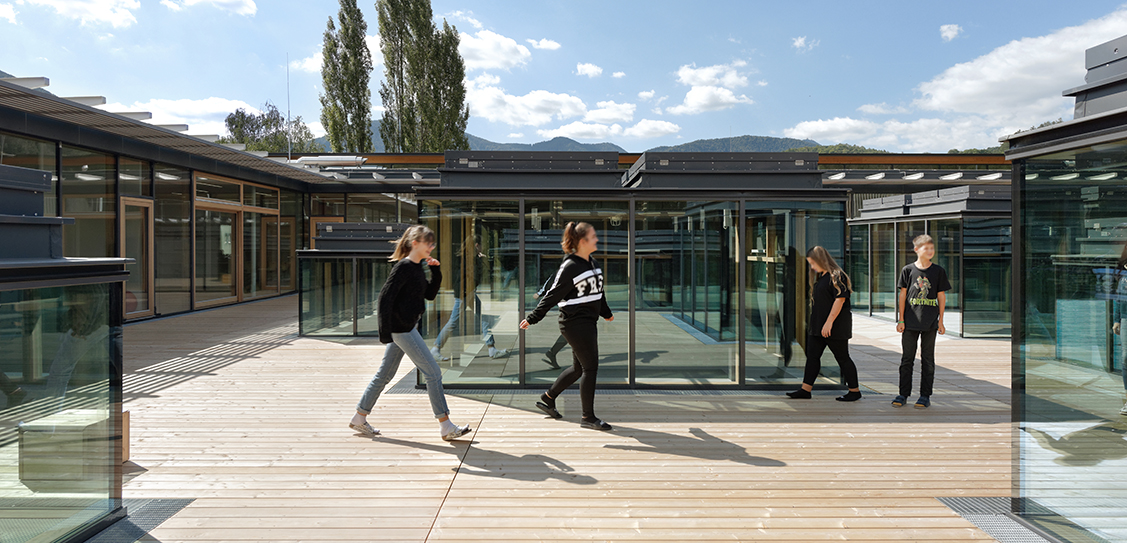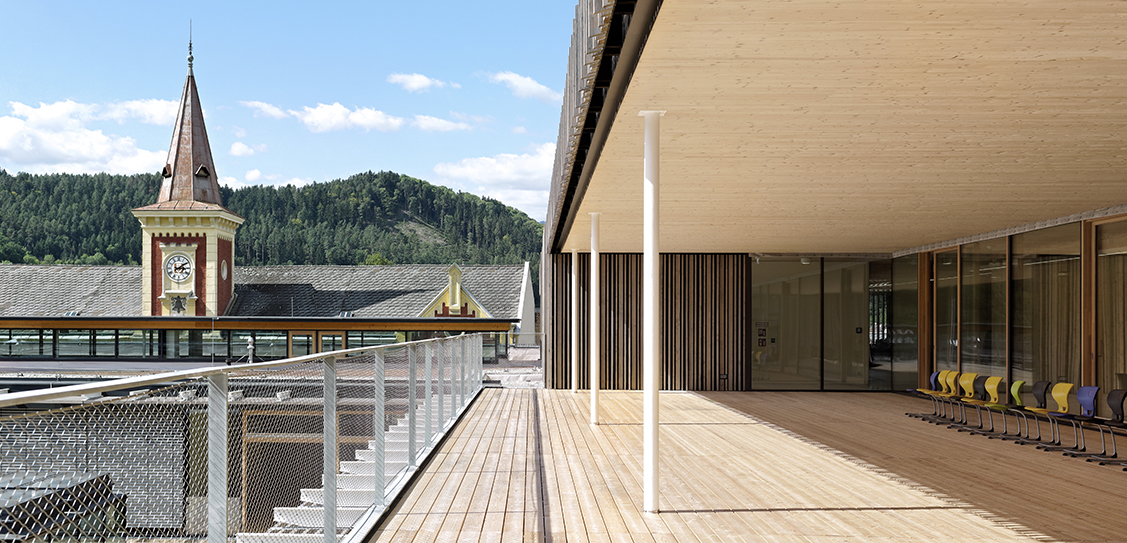Gloggnitz is a municipality with 6,000 inhabitants, 80 km southwest of Vienna, situated at the foot of the Rax in the Austrian Prealps. Gloggnitz is an industrial town and regional centre, with a struggling village centre.
The small town decided to bundle its three so far separate schools (elementary school, new middle school, special educational centre) in the Schulgasse in an attractive, common new building and to strengthen the location. Two existing buildings were demolished in order to give the new building the greatest possible presence in the town centre.
The school centre offers special teaching units: a music school, a training workshop equipped with workbenches, a well-equipped teaching kitchen, computer science and physics rooms and more. At the same time, the school opens to the city by hosting sports clubs, involving adult education and providing extra-curricular events.
The base of the school centre symbolises openness. It is completely glazed and thus permeable between inside and outside. The entrance is located close to the centre in the north-west at a large public forecourt. The cantilevered first floor forms a wide canopy, which creates a weather-protected forecourt for the entrance area and literally pulls you inside. It forms the transition from the public outdoor area to the interior of the school.
Skylight domes illuminate this open, central area with natural light, which is supported by a filigree, optimised, three-dimensional steel framework and spans 30 m. The architecture of this spatial volume implements the ambitious, educational programme of the new open and integrative school in three dimensions.
The focus of the new secondary school is on sports, and in general, exercise is important for all children. It promotes concentration, coordination and learning ability in a holistic way. The rooms adapted to the different activities, the common gymnasium, the gymnastics hall, the climbing wall - stretch over all levels, from its floor level in the basement to its roof terrace on the first floor. Their clearance forms the luminous centre of the foyer: glass balustrades and fine tensioned cable mesh as safety and ball throwing nets generate a visually continuous open space. The sports areas are bordered on two sides by glazed seating tribunes. They turn the gymnasium, gymnastics hall and climbing wall into a scene.
The school centre is very clearly structured. The ground floor is the public area: at the entrance are two cloakrooms located, all classes for practical teaching and special lessons are arranged in a ring around the clear space for sports and exercise. They are easily accessible for external use via the foyer or the side entrances. The vertical circulation, stairs and lift, are placed in the edges of the building. The stairs designed as emergency exits are normally open. In case of a fire the access doors close automatically.
All classrooms for all three school types are located on a common level on the first floor. Their centre is formed by the wooden roof terrace with prism-shaped skylight lanterns on the spacious volume of the sports areas. They provide a differentiated division of this large, common open space for all, which can also be used as an “open-air classroom”. Around this open courtyard, a new school is organised according to the cluster concept: openable classrooms are grouped around a so-called “marketplace”; which merges into the open circulations. In this way, lessons can take place in an open space situation involving several classes. In that way, all areas become the setting for joint learning and living together across school types.
The teacher and administration areas are located on the second floor, which as a slender transom of the façade over the main entrance in the north-west gives more height and thus weight to the building. All rooms for teaching staff and management are arranged along a transparent corridor and around an internal terrace in the southeast.
The calm, unobtrusive, wood-clad structure of the school building, which rests on a transparent base, offers an undreamt-of degree of spatial diversity, sports and further education opportunities. Its opening was a folk festival; the best prerequisites for it to become a permanent cultural hub for the community.
The foyer on the ground floor forms the continuity of the covered the public forecourt of the school and the wide hall. The safety barriers and ball throwing protection of the gymnasiums are formed by room-high spanned cable nets. This allows easy ventilation and keeps the space visually completely open.
The classes for special lessons are situated in a ring around this area and allows easy direct use for after school and out of school activities and sport clubs. Access can be provided from the side entrances.
The vertical accesses, stairs and lift, are situated in the corners of the building. The stairs, designed as emergency exits, stand open during normal use. In case of fire the doors close automatically.
The normal classrooms for all three school types are located on the first floor. They form a continuous ring around the accessible inner yard. The individual classes are grouped into three clusters with a shared space open to this inner yard. The walls of the classes facing this common space are designed as folding elements and can be opened up over the entire length of the area.
That way lessons can take place in an open space situation involving several groups. The so-called ‘market place’, can be used for out-of-class activities and for learning together.
The wooden exterior yard in the centre is divided by prism-shaped volumes. The volumes create differentiated areas; they also provide natural lighting and ventilation to the gymnasiums. The ventilation louvers in case of fire are integrated into the prisms.
The teachers rooms and the administration on the 2nd floor can be reached directly from the entrance hall via the stairs and lift.
A ventilation concept has been implemented considering the excellent geographic location of the Gloggnitz municipality. Therefore, the classrooms are supplied with natural fresh air during the lessons mainly over automatically regulated window wings. The regular control takes place via constantly determined CO² values in the classrooms and guarantees thereby an efficient, energetically economical and natural ventilation. During breaks and overnight a shock ventilation is carried out for quick air exchange.
Three ventilation wings per class are integrated into the façade. Two wings are motorised and linked to the automatic system. The third wing is located near the teacher’s desk. It can be operated manually and can be opened or closed according to individual needs. The automatic wings are shielded by an element of expanded metal.
In addition to the automatic window ventilation, a mechanical ventilation system is integrated into the concept, whereby additional fresh air is generated in the classrooms. During breaks and overnight a shock ventilation is carried out for quick air exchange. Extraction takes place in the rooms for equipment of the gymnasiums.
Soundproofed overflow elements in the walls of the classrooms and the permanently open staircases ensure the ventilation path. These overflow elements were specially designed for the school.
The classes are heated by low-temperature radiators. The radiators are installed in the area of the parapet. The parapet is at table height and offers a direct view to the exterior. The wooden layering on the façade provides additional protection against falling in the area of the opening wings.
The heating room is located in a prefabricated heating container in the immediate proximity of the school. The energy sources are locally produced wood chips and are thus considered to be climate neutral.
In addition to air quality, the well-being of a person is also ensured by natural light. The central area is flooded with daylight via glass elements integrated into the patio’s superstructure on the first floor. The light is alternately reached cenitally via the glazed cover of the elements with a dimension of four by four metres and the lateral glazing of the smaller elements, two by four metres.
Sound absorption in the central room is provided by wood-based panels mounted on the false ceiling. In the classrooms, the walls are equipped to absorb sound.
A specially adapted fire protection system is required and designed for the open merging spaces. The open and fluid layout of the building requires a specific fire protection concept and especially a unique solution for smoke extraction in case of fire. The incoming air in case of fire is supplied via automatically opening doors integrated in the façade.
The outgoing air is extracted via the top elements above the gymnasiums. Smoke flaps open at the high points and enable efficient smoke extraction. In everyday use open staircases are closed in case of fire automatically with fire resistant doors, but can be used as emergency exits.
Materials are used in their raw form, the load bearing or stiffening concrete slabs are made in fair-faced concrete quality. Wood is the dominant material; the supporting laminated ceilings and the wooden floors shape the spatial atmosphere. The frames of the opening elements in the façade consist of wood-aluminum profiles and large format sliding doors open the shared “market places”, to the patio on the first floor.
The solid parts of the façade are equipped with vertical wooden laths. In the patio, a wood lathed cantilevered roof forms the sun protection. Furthermore, the glass surfaces are provided with external slat blinds for shading and darkening.
The optimised supporting structure, adapted to the spatial and structural situations. The load-bearing components are made of concrete, steel and wood. The use of the materials is determined by the special position of these elements in the building. The basement and the stiffening walls of the staircases are made of fair-faced concrete. Delicate steel columns and wall panels of solid laminated timber on the upper floor complete the supporting structure.
The large central ceiling of the gymnasiums is spanned by a three-dimensional steel framework optimised in its height. The floor slabs are supported by steel beams. They are made from visible laminated timber elements. The non-accessible, slightly inclined roofs are extensively greened.



